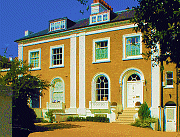|
A Georgian and Victorian residential locality centred on a ‘boulevard’ that leads from Barnes to Hammersmith Bridge,
lined with substantial detached family homes with large gardens. The Castelnau area is increasingly considered to include
Barn Elms common and playing fields. Until the opening of Hammersmith Bridge in 1827 the only way to cross the river was by
ferry from Chiswick. When Major Charles Lestock Boileau built his home here he called it Castelnau House after his family’s
former estate of Castelnau de la Garde, near Nīmes in France. Boileau’s family were Huguenots who had fled to England
to escape religious persecution and settled in Mortlake. In 1843 Boileau began to build Castelnau Villas and several rows
of cottages. The church of Holy Trinity was consecrated in 1868, by which time the settlement had around 140 houses and 800
residents. The population had more than doubled when Holy Trinity became a parish in 1888. After Boileau’s death the
following year Upper Bridge Road was renamed Castelnau. With the sale of the Boileau estate more streets were laid out and
lined with housing over the next two decades. In 1928 the London County Council laid out an estate of 640 houses on the western
side of Castelnau, with streets named after deans of St Paul’s, former lords of the manor of Barnes. This increased
the housing stock to 2,000 and the population to over 5,000. Castelnau House was demolished in the early 1960s and replaced
by a public library. The north-western rim of the peninsula has the Harrodian, Swedish and St Paul’s schools.
 |

